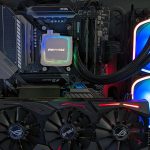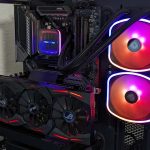Methodology
An AMD Ryzen 9 3950X has to be cooled at various power consumption levels, along with 16GB of Crucial Ballistix Sport (2x8GB) DDR4 RAM on an MSI B550 Tomahawk (BIOS 7C91vAB). The Asus ROG Strix GTX 1060 6GB runs for the CPU stress tests only for the image output in zero-fan mode and a Fractal Design Ion Gold 750W serves as the power source. The whole thing is located in the Thermaltake Core P3 as an open benchtable.
The test system runs on Windows 10 Pro 22H2 (Build 19045.2251). All data sets are recorded with HWInfo64 v7.34-4930 – 5000ms logging, the specified temperature results from the CPU Die (Average) sensor. Since I don’t have air conditioning, the values in the graphs are the delta between room temperature and CPU temperature. This means that all cooling systems can be compared fairly, even if the ambient temperature is different. The heat-conducting paste supplied with the cooler or applied beforehand is used in each case.
I determine the sound level with a Voltcraft SL-200 measuring device at a distance of 40 cm, which works in 125 ms cycles in Lo mode. The room was measured at 33.2 dB(A), an external example table helps to break it down.
Benchmarks
In the first test run, a loudness of 40 dB(A) was set at 40cm from the center of the pump and fan on the radiator, in my setup this is 41% PWM for the 240mm version and 44% PWM for the 360mm version for the radiator fans and 100% PWM for the pump in each case:
And after that, this cooler is still allowed to show what it can achieve in terms of cooling performance at maximum speed, regardless of the volume. A maximum of 53.5 dB(A) was measured for the 240mm version and 52.6 dB(A) for the 360mm at 100% PWM and a distance of 40cm.
A full comparison with other coolers can be found here:
Roundup and re-measurement of all tested CPU air and water coolers
Summary and conclusion
A pretty exterior is not enough for a good result here, the cooling performance must also be right. In the overall overview, the 240 version lands right in the middle, but has to admit defeat to the slightly cheaper Xilence LQ240PRO.
Depending on the color, the version with 360mm radiator is available for a moderate surcharge at the time of testing, but it only makes it to one of the last places in the comparison. Of course, it should always be noted that the actual temperature difference is quite small.
Enermax does not offer an extended manufacturer’s warranty, so unfortunately only the statutory 2 years remain. In return, there is an unusual, asymmetrical fan design and rather low pricing. The bright white in particular can certainly come into its own in a color-coordinated system.
The test sample was provided by Enermax without obligation. There was and is no influence on the tests and results. There was also no compensation for expenses and no obligation to publish.
Enermax AquaFusion ADV 240 (ELC-AQFA240-SQA)
 | Auf Lager | 74,90 €*Stand: 27.07.24 03:10 |
 | Ab Lager lieferbar - Lieferzeit 2-4 Werktage | 77,60 €*Stand: 26.07.24 21:55 |
 | Alsdorf: bei Vorbestellung in ca. 24h - 48h lagerndVersandlager: lagerndStand: 26.07.24 23:45 | 79,50 €*Stand: 26.07.24 23:47 |
Enermax AquaFusion ADV 360 (ELC-AQFA360-SQA)
 | Auf Lager | 94,90 €*Stand: 27.07.24 03:10 |
 | Bestellware - 9-11 Tage Lieferzeit | 96,89 €*Stand: 27.07.24 02:14 |
 | Lager Lieferant: Sofort lieferbar, 1-3 Werktage | 96,89 €*Stand: 27.07.24 03:05 |











































37 Antworten
Kommentar
Lade neue Kommentare
Urgestein
Urgestein
Urgestein
Mitglied
Urgestein
Urgestein
Urgestein
Urgestein
Urgestein
Urgestein
Urgestein
Urgestein
Veteran
Moderator
Moderator
Moderator
Veteran
Alle Kommentare lesen unter igor´sLAB Community →